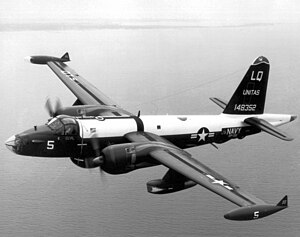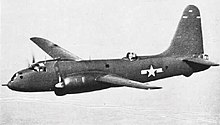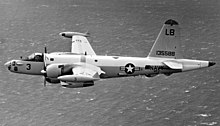Lockheed P-2
| Lockheed P2V / P-2 Neptune | |
|---|---|
 Lockheed P-2H (P2V-7) "Neptune" of the US Navy 1963 |
|
| Type: | Maritime patrol aircraft |
| Design country: | |
| Manufacturer: | |
| First flight: |
May 17, 1945 |
| Commissioning: |
March 1947 |
| Production time: |
1946 to 1962 |
| Number of pieces: |
1,118 |
The Lockheed P2V (from 1962: P-2 ) Neptune was a twin-engine naval aircraft made by the United States . It was the first land plane specially designed as a maritime patrol aircraft. Another purpose was the submarine hunt . Built from 1945, the Neptune had one of the longest service lives of any military aircraft ever built.
history
The first design studies for the machine began in September 1941 at the Lockheed subsidiary Vega. However, the Second World War prevented further development. In 1944, the US Navy then ordered two XP2V-1 prototypes and fourteen series machines. The first prototype of the P2V-1 flew on May 17, 1945 and showed very good flight characteristics. The delivery of the first of 100 machines ordered to the Navy began in December 1945. However, the end of the Second World War stopped further production and only in September 1946 another 30 machines of the P2V-2 version were ordered. This got a 0.76 m longer hull, stronger armament and a stronger drive with four-blade controllable pitch propellers instead of the previous three-blade propellers. In March 1947, the first squadron of the P2V-1, the VPML-2, was declared operational. The P2V-2 also reached operational readiness this year. The last machines in this series were delivered in July 1948. The first flight of the P2V-3 took place in August 1948. This variant, which was built until 1949, was equipped with more powerful R-3350 drives with 2386 kW each.
First carrier-supported atomic bomb carrier
After the end of World War II, the US Navy saw the need for its own carrier-based nuclear force as imperative, as the fleet had been greatly reduced after the armistice. The carrier aircraft commissioned accordingly in June 1946 was the North American AJ Savage , which, however, would not be available until 1949. The only US Navy aircraft that was able to take off from an aircraft carrier with a 4,500 kg (10,000 lb) bomb was the Neptune. Two P2V-2s were fitted with JATO devices. This system was successfully tested on April 27, 1948 with the take-off from the aircraft carrier USS Coral Sea and twelve machines were commissioned as P2V-3C. The machines were used between September 1948 and 1950 with the specially founded Composite Heavy Attack Squadron VC-5 in Moffet Field and from January 1950 with the VC-6.
Further development
The next version was the P2V-4, which was produced until 1950. This received R-3350 engines ( turbo-compound engines ) equipped with exhaust gas turbines , additional wing tip tanks or, optionally, an AN / APS-31 radar, an enlarged radar cover for the AN / APS-20 radar under the front fuselage and was able to be released Sonar buoys equipped. In accordance with the new naming system introduced by the Navy in 1962, this machine was later called the P-2D. The very successful P2V-5 was first launched on December 29, 1950. More than 400 of it were built in six versions. It initially differed from the P2V-4 in that it had a larger fuel capacity and, in accordance with the planned purpose for combating ship targets, with additional electronics, for example for electronic countermeasures, which was operated by an additional ninth crew member. A searchlight was also installed in the right wing end tank. The machines were later converted to the P2V-5F. For this, the arms were removed and replaced by a glass dome at the bow or a MAD boom at the stern. The main difference, however, was the installation of two additional jet engines in nacelles under the wings to improve flight performance. Many older machines or later versions without additional engines were also retrofitted accordingly. The prototype of the P2V-6 took off on its maiden flight in October 1952, with extensive electronic equipment being used. The last version was the P2V-7, which took off for its first flight on April 26, 1954 and was produced until the early 1960s. It received the 15 kN J-34-WE-34 jet engines, the MAD boom at the stern, an enlarged cockpit, more streamlined wing end tanks and some modernized systems as standard.
A total of 1118 machines of all versions were built; they were the US Navy's main anti-submarine fighter aircraft in the 1950s and were also widely used as reconnaissance aircraft. It was used in the Korean and Vietnam War and served as a reconnaissance officer during the Cuba crisis. After several modernization programs, their active service ended in 1970 when the last operational squadron VP-23 retired their SP-2H. Until the late 1970s, it was only found in a few reserve units.
The last seven P2V-5 and -7 from Neptune Aviation , Missoula (Montana), which were in service as fire-fighting aircraft, were decommissioned in 2017 and replaced by converted BAe 146s . The P2Vs were given to various museums. During its service life as a fire fighting aircraft, the P2V fleet has flown 47,000 sorties and dropped 97 million gallons of extinguishing agent.
Versions
- XP2V-1
- Prototype, one built.
- P2V-1
- Series version with 2300 hp R-3350-8 engines, 15 built.
- P2V-2
- elongated hull, reinforced armament, 81 built.
- P2V-2N "Polar Bear"
- a converted P2V-2 with ski landing gear and magnetic anomaly detector (MAD) .
- P2V-3
- 3200 hp R-3350-26W engines, 83 built.
- P2V-3C
- P2V-3 with devices for launching aircraft carriers, 11 built.
- P2V-3B
- 16 converted P2V-3s with ASB-1 target radar.
- P2V-3W
- Early warning aircraft with radar APS-20, 30 built.
- P2V-3Z
- VIP transporter or flying command post, 2 built.
- P2V-4 (P-2D)
- 3250 hp R-3350-30W engines, additional tanks under the wing tips, 52 built, standard radar fairing under the fuselage.
- P2V-5
- Emmerson turret with two 20mm cannons in the aircraft nose, APS-20 and APS-8 radar, wing tip tanks. During production, the tower was left out and a MAD was installed in the stern instead of the stern tower. 424 built.
- P2V-5F (P-2E)
- P2V-5 each with a Westinghouse J-34-WE-34 jet engine under the wings.
- AP-2E
- Converted P-2E for the United States Army , which was used with SIGINT / ELINT equipment in the Vietnam War .
- P2V-5FD (DP-2E)
- P2V-5F converted as unarmed target tow planes.
- P2V-5FE (EP-2E)
- P2V-5F with special electronics equipment.
- P2V-5FS (SP-2E)
- P2V-5F with Julie / Jezebel equipment for submarine hunting.
- OP-2E
- 12 P-2E converted for the “ Igloo White ” program. It was used to track down Viet Cong fighters in the Vietnam War . The Navy Squadron VO-67 deployed the SUU-11 / A six-barreled 7.62mm revolver cannons between February 1967 and July 1968 over Southeast Asia.
- P2V-6 (P-2F)
- R-3350-36WA engine, APS-70 radar, could throw mines, 83 built.
- P2V-6B (P2V-6M, MP-2F)
- 16 P2V-6 capable of launching Fairchild AUM-N-2 (AQM-41) Petrel missiles .
- P2V-6F (P-2G)
- P2V-6 / P-2F with J-34 jet engines.
- P2V-6T (TP-2F)
- P-2F converted as an unarmed trainer.
- P2V-7 (P-2H)
- 3500 hp R-3350-32W engines, standard with J-34 jet engines, improved wing tip tanks, APS-20 radar, glazed nose and MAD in the stern, 311 built.
- P2V-7LP (LP-2J)
- Ski undercarriage and jump start kits (JATO) , 4 built.
- P2V-7S (SP-2H)
- P2V-7 with Julie / Jezebel equipment for submarine hunting.
- AP-2H
- 4 P-2H with equipment for ground attacks.
- RB-69A (P2V-7U)
- P-2H for the CIA with Side Looking Airborne Radar (SLAR) , five built, two converted. Flew reconnaissance with United States Air Force markings for the CIA.
- Neptune MR.1
- Designation for 52 P2V-5s delivered to the Royal Air Force .
- CP-122 Neptune
- Name for P2V-7 shipped to Canada .
- P2V wharf (P-2J)
- Kawasaki-built P-2 with T64 turboprops and IHI-J3 jet engines (J-34 built under license), improved avionics and APS-80 radar. 82 built.
production
As part of the Mutual Defense Aid Program (MDAP), the Neptune was also delivered to allied nations. Australia received two P2V-4s in 1951. Another ten P2V-5s were purchased and delivered in 1952 (6) and 1953 (4). Great Britain received a total of 52 P2V-5s in 1952 (3), 1953 (48) and 1955 (1), the Netherlands received a total of 10 P2V-5s in 1953 (3) and 1954 (7). The P2V-6 from the MDAP production went to the French naval aviators .
Acceptance of the Lockheed Neptune by the US Navy:
| version | 1946 | 1947 | 1948 | 1949 | 1950 | 1951 | 1952 | 1953 | 1954 | 1955 | 1956 | 1957 | 1958 | 1959 | 1960 | 1961 | 1962 | TOTAL |
|---|---|---|---|---|---|---|---|---|---|---|---|---|---|---|---|---|---|---|
| XP2V-1 / P2V-1 | 2 | 14th | 16 | |||||||||||||||
| P2V-2 | 34 | 45 | 1 | 80 | ||||||||||||||
| P2V-3 | 29 | 22nd | 2 | 53 | ||||||||||||||
| P2V-3W | 16 | 14th | 30th | |||||||||||||||
| P2V-4 | 1 | 44 | 7th | 52 | ||||||||||||||
| P2V-5 | 40 | 50 | 119 | 140 | 349 | |||||||||||||
| P2V-5 MDAP | 4th | 14th | 46 | 1 | 65 | |||||||||||||
| P2V-5 sale | 12 | 12 | ||||||||||||||||
| P2V-6 | 7th | 50 | 57 | |||||||||||||||
| P2V-6 MDAP | 27 | 27 | ||||||||||||||||
| YP2V-7 | 3 | 3 | ||||||||||||||||
| P2V-7 | 19th | 47 | 30th | 22nd | 11 | 23 | 25th | 21st | 5 | 203 | ||||||||
| P2V-7 Canada | 1 | 24 | 25th | |||||||||||||||
| RB-69A CIA | 4th | 4th | ||||||||||||||||
| P2V-7 Japan | 1 | 5 | 3 | 7th | 16 | |||||||||||||
| P2V-7 France | 16 | 10 | 7th | 33 | ||||||||||||||
| P2V-7 Netherlands | 9 | 6th | 15th | |||||||||||||||
| P2V-7 Australia | 12 | 12 | ||||||||||||||||
| TOTAL | 2 | 48 | 74 | 39 | 61 | 51 | 83 | 242 | 164 | 72 | 39 | 25th | 34 | 33 | 25th | 37 | 23 | 1052 |
Military users
-
 Argentina
Argentina
- 8th
-
 Australia
Australia
- Royal Australian Air Force
-
 Brazil
Brazil
- Força Aérea Brasileira : 14
-
 Canada
Canada
-
 Chile
Chile
-
 China
China
-
 France
France
- French Navy
-
 Japan
Japan
-
 Netherlands
Netherlands
- Royal Navy
-
 Portugal
Portugal
-
 United Kingdom
United Kingdom
- Royal Air Force : 52 P2V-5 Neptune MR.1
-
 United States
United States
- United States Army
- United States Navy
- Central Intelligence Agency 7 RB-69A in USAF designation.
Incidents
During the Cold War , a P2V was shot down on November 6, 1951 by a Soviet Lavochkin La-11 fighter aircraft over the Sea of Japan during a reconnaissance mission . The ten crew members are still missing today.
On January 18, 1953, a P2V was hit by Chinese coastal batteries and plunged into the Strait of Formosa . Eleven crew members were reached by a PBM-5G Mariner aircraft of the US Coast Guard . However, the naval plane also crashed in rough seas. The US destroyer Halsey Powell was able to save eleven people, including seven of the crashed P2V.
Technical specifications
| Parameter | Data (P2V-2) | Data (P2V-5F) | Data (P2V-7) |
|---|---|---|---|
| crew | 7th | 10 | 10 |
| length | 23.8 m | 27.8 m | 27.83 m |
| span | 30.5 m | 31.65 m | 31.65 m |
| height | ? m | ? m | 8.94 m |
| Empty mass | ? t | 18.9 t | 19.5 t |
| Takeoff mass | 28.6 t | 34.5 t | 36.3 t |
| Top speed | 515 km / h | 520 km / h | 586 km / h |
| Marching speed | 287 km / h | 333 km / h | 300 km / h |
| Service ceiling | 7925 m | 7700 m | 6830 m |
| Range | 6410 km | 7650 km | 7000 km |
| Engines | 2 radial engines Wright R-3350-24W with 2090 kW starting power each | 2 radial engines Wright R-3350-30W with 2800 kW each and 2 jet engines Westinghouse J34 -WE-34 with 15 kN each |
2 radial engines Wright R-3350-32W Cyclone with 2985 kW each and 2 jet engines Westinghouse J34 -WE-36 with 15 kN thrust each |
| Armament | Max. Weapon load 3629 kg, suspension for unguided air-to- surface missiles under the wings, bomb bay for depth charges , torpedoes and sea mines |
See also
Web links
- Patrol Squadron 65 History with the Neptune
- P2 development history
- Mid-Atlantic Air Museum: Lockheed P2V Neptune
- French Navy Neptune ( Memento from January 6, 2002 in the Internet Archive )
- US Navy Patrol Squadrons: Lockheed P2 Neptune
- US Navy Patrol Squadrons: "Flight of the Truculent Turtle"
- Aero Union Corporation
- Listing of the carrier launch conversions
- Observation Squadron Sixty-Seven
- Robert Fulton's Skyhook and Operation Coldfeet, use of P2V aircraft
- Use of P2V aircraft for Operation Deep Freeze by the US Navy's squadron VX-6
- AeroWeb: List of P-2 Neptunes on display.
- DND - Canada's Air Force - Lockheed CP-127 (P2V-7) Neptune
Individual evidence
- ↑ a b c FliegerRevue January 2012, pp. 68–71, Lockheed P-2 Neptune
- ↑ Duane Kasulka: USN Aircraft Carrier Air Units - Vol 1 1946-1956.. Squdron / Signal Publ. 1985.
- ^ Neptune Yesterday. Fleet history on the company website of Neptune Aviation , English, accessed on October 27, 2019
- ↑ ADF Serials. Retrieved June 19, 2019 .
- ↑ Geldhof, N .: 70 Jaar Marineluchtvaartdienst , Leeuwarden 1987, p. 205
- ↑ Statistical Digest of the USAF 1946 , p. 94 ff; 1947, p. 115; 1948II, p. 16; 1949, p. 164 ff .; 1951, p. 153 ff .; 1952, p. 153 ff .; 1953, p. 185; 1954, p. 70; 1955, p. 80; 1956, p. 91; 1957, p. 97; Air Britain: The SP-2H Neptune in US Navy service , in: Areromilitaria, Spring 2008 to Winter 2008
- ↑ Geldhof, N .: 70 Jaar Marineluchtvaartdienst , Leeuwarden 1987, p. 207
- ↑ DPMO Cold War Incidents Report: Incident Data 2000-08-31 ( Memento of February 14, 2010 in the Internet Archive )
- ↑ a b c vectorsite: The Lockheed P2V Neptune & Martin Mercator










